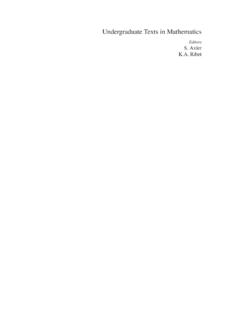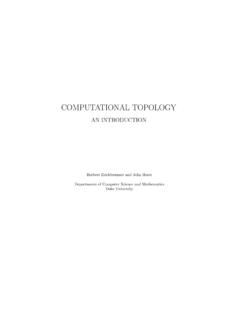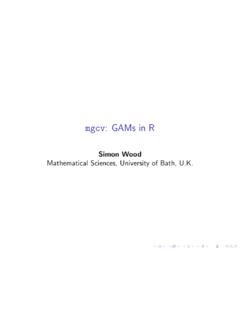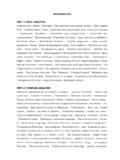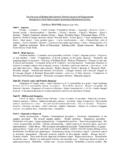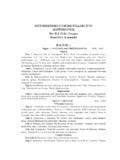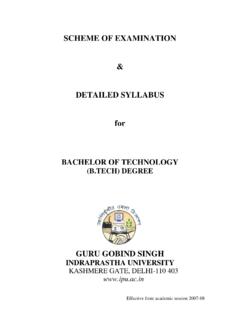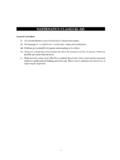Transcription of Chapter 2 Complex Analysis - School of Mathematics
1 Chapter 2 Complex AnalysisIn this part of the course we will study some basic Complex Analysis . This isan extremely useful and beautiful part of Mathematics and forms the basisof many techniques employed in many branches of Mathematics and will extend the notions of derivatives and integrals, familiar from calculus,to the case of Complex functions of a Complex variable. In so doing we willcome across analytic functions, which form the centerpiece of this part of thecourse. In fact, to a large extent Complex Analysis is the study of analyticfunctions. After a brief review of Complex numbers as points in the complexplane, we will first discuss analyticity and give plenty of examples of analyticfunctions.
2 We will then discuss Complex integration, culminating with thegeneralised Cauchy Integral Formula, and some of its applications. We thengo on to discuss the power series representations of analytic functions andthe residue calculus, which will allow us to compute many real integrals andinfinite sums very easily via Complex Analytic functionsIn this section we will study Complex functions of a Complex variable. Wewill see that differentiability of such a function is a non-trivial property,giving rise to the concept of an analytic function. We will then study manyexamples of analytic functions. In fact, the construction of analytic functionswill form a basicleitmotiffor this part of the The Complex planeWe already discussed Complex numbers briefly in The emphasisin that section was on the algebraic properties of Complex numbers, and73although these properties are of course important here as well and will beused all the time, we are now also interested in more geometric properties ofthe Complex setCof Complex numbers is naturally identified with the is often called theArgand a Complex numberz=x+i y, its real and imag-6-z=x+iyyx7inary parts define an element (x, y) ofR2, as shown inthe figure.
3 In fact this identification is one of real vec-tor spaces, in the sense that adding Complex numbersand multiplying them with real scalars mimic the simi-lar operations one can do inR2. Indeed, if Ris real,then to z= ( x) +i( y) there corresponds the pair( x, y) = (x, y). Similarly, ifz1=x1+i y1andz2=x2+i y2are com-plex numbers, thenz1+z2= (x1+x2) +i(y1+y2), whose associated pairis (x1+x2, y1+y2) = (x1, y1) + (x2, y2). In fact, the identification is evenone of euclidean spaces. Given a Complex numberz=x+i y, its modulus|z|, defined by|z|2=zz , is given by x2+y2which is precisely the norm (x, y) of the pair (x, y). Similarly, ifz1=x1+i y1andz2=x2+i y2,then Re(z 1z2) =x1x2+y1y2which is the dot product of the pairs (x1, y1)and (x2, y2).
4 In particular, it follows from these remarks and the triangleinequality for the norm inR2, that Complex numbers obey a version of thetriangle inequality:|z1+z2| |z1|+|z2|.( )Polar form and the argument functionPoints in the plane can also be represented using polar coordinates, andthis representation in turn translates into a representation of the (x, y) be a point in the plane. If we definer= r7z=rei x2+y2and by = arctan(y/x), then we can write(x, y) = (rcos , rsin ) =r(cos ,sin ). The complexnumberz=x+i ycan then be written asz=r(cos +isin ). The real numberr, as we have seen, is the modulus|z|ofz, and the Complex number cos +isin has unitmodulus.
5 Comparing the Taylor series for the cosine andsine functions and the exponential functions we notice that cos +isin =ei .The angle is called theargumentofzand is written arg(z). Therefore we74have the followingpolar formfor a Complex numberz:z=|z|eiarg(z).( )Being an angle, the argument of a Complex number is only defined up to theaddition of integer multiples of 2 . In other words, it is amultiple-valuedfunction. This ambiguity can be resolved by defining theprincipal valueArg of the arg function to take values in the interval ( , ]; that is, for anycomplex numberz, one has <Arg(z) .( )Notice, however, that Arg is not a continuous function: it has a discontinuityalong the negative real axis.)
6 Approaching a point on the negative real axisfrom the upper half-plane, the principal value of its argument approaches ,whereas if we approach it from the lower half-plane, the principal value ofits argument approaches . Notice finally that whereas the modulus is amultiplicative function:|zw|=|z||w|, the argument is additive: arg(z1z2) =arg(z1) + arg(z2), provided that we understand the equation to hold up tointeger multiples of 2 . Also notice that whereas the modulus is invariantunder conjugation|z |=|z|, the argument changes sign arg(z ) = arg(z),again up to integer multiples of 2 .Some important subsets of the Complex planeWe end this section with a brief discussion of some very important subsetsof the Complex plane.
7 Letz0be any Complex number, and consider all thosecomplex numberszwhich are a distance at most away fromz0. Thesepoints form a disk of radius centred atz0. More precisely, let us define theopen -disk aroundz0to be the subsetD (z0) of the Complex plane definedbyD (z0) ={z C||z z0|< }.( )Similarly one defines theclosed -diskaroundz0to be the subset D (z0) ={z C||z z0| },( )which consists of the open -disk and the circle|z z0|= which forms itsboundary. More generally a subsetU Cof the Complex plane is said to beopenif given anyz U, there exists some positive real number >0 (whichcan depend onz) such that the open -disk aroundzalso belongs toU. A setCis said to beclosedif its complementCc={z C|z6 C} that is, all75those points not inC is open.
8 One should keep in mind that generic subsetsof the Complex plane are neither closed nor open. By aneighbourhoodof apointz0in the Complex plane, we will mean any open set containingz0. Forexample, any open -disk aroundz0is a neighbourhood ofz0. Let us see that the open and closed -disks are indeed open and closed, respectively. Letz D (z0). This means that|z z0|= < . Consider the diskD (z). We claim thatthis disk is contained inD (z0). Indeed, if|w z|< then,|w z0|=|(w z) + (z z0)|(adding and subtractingz) |w z|+|z z0|(by the triangle inequality ( ))< + = .Therefore the diskD (z0) is indeed open. Consider now the subset D (z0). Its complementis the subset of pointszin the Complex plane such that|z z0|>.
9 We will show that itis an open set. Letzbe such that|z z0|= > . Then consider the open diskD (z),and letwbe a point in it. Then|z z0|=|(z w) + (w z0)|(adding and subtractingw) |z w|+|w z0|.(by the triangle inequality ( ))We can rewrite this as|w z0| |z z0| |z w|> ( )(since|z w|=|w z|< )= .Therefore the complement of D (z0) is open, whence D (z0) is should remark that the closed disk D (z0) is not open, since any open disk around apointzat the boundary of D (z0) that is, for which|z z0|= contains points whichare not included inD (z0).Notice that it follows from this definition that every open set is made out of the union of(a possibly uncountable number of) open Complex -valued functionsIn this section we will discuss Complex -valued start with a rather trivial case of a Complex -valued function.
10 Supposethatfis a Complex -valued function of a real variable. That means that ifxisa real number,f(x) is a Complex number, which can be decomposed into itsreal and imaginary parts:f(x) =u(x)+i v(x), whereuandvare real-valuedfunctions of a real variable; that is, the objects you are familiar with fromcalculus. We say thatfiscontinuousatx0ifuandvare continuous atx0. Let us recall the definition of continuity. Letfbe a real-valued function of a real say thatfis continuous atx0, if for every >0, there is a >0 such that|f(x) f(x0)|< whenever|x x0|< . A function is said to be continuous if it is continuousat all points where it is consider a Complex -valued functionfof a Complex variablez.

